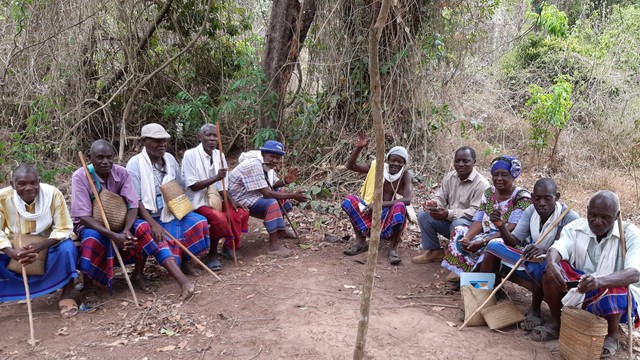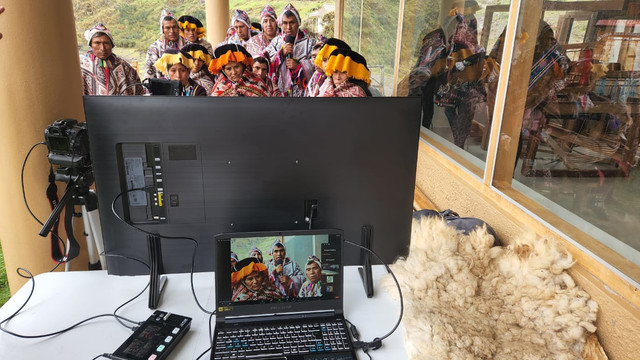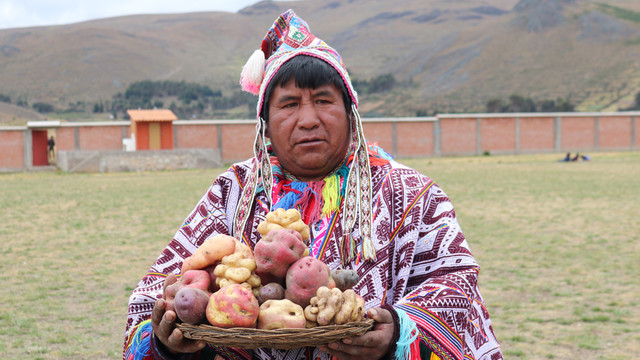Community protocols can bring real benefits to communities and combat biodiversity loss
Community Protocols are a vital way forward for negotiating agreements that are equitable, and conserve their local biodiversity and traditional knowledge.


Traditional woman farmer selecting seeds. Eastern Himalayas, India. IIED works directly with local communities to protect and promote their traditional farming techniques in order to strengthen their ability to cope with the impacts of climate change.
Photo credit: Ruchi Pant/Ecoserve.
Indigenous people and local communities have received few benefits from the commercial use of the wealth of traditional crops and medicinal knowledge they have developed. Where agreements have been established, the benefits are insignificant compared to the huge profits derived by companies. At the same time, biodiversity and traditional knowledge are being lost at an unprecedented rate.
Community Protocols provide communities with a vital way forward for negotiating agreements that are equitable, and for conserving their local biodiversity and traditional knowledge.
They set out a community’s rights and responsibilities relating to natural resources, to help communities defend these rights and negotiate with others on an equal footing. They can also establish internal community rules for the equitable sharing of benefits and for sustainable management of natural resources.
High up in the Peruvian Andes, such an agreement to equitably share benefits and conserve the Potato Park’s unique bio-cultural system has been developed (Read the summary and detailed case study).
Quechua communities are communally farming hundreds of potato varieties in the Park, which are vital for their food security and resilience to climate change. Having signed an agreement with a gene bank (the International Potato Centre) for the repatriation of lost potato varieties, the six communities needed to establish internal rules for the fair sharing of potatoes and financial benefits amongst them.
Community agreement helps conserve potato diversity and reduce potential conflict
The 6 communities carried out an in-depth participatory process over 2 to 3 years to develop an inter-community agreement. This agreement established new inter-community governance structures and a framework for equitably sharing the benefits from a number of economic collectives in the park, including collectives benefiting from gastronomy and ecotourism initiatives, and the production and selling of medicinal plants, potatoes and crafts. The agreement is rooted in conservation and equity values enshrined in customary laws, which now shape all the activities of the park, and is regulated by the community and inter-community authorities.
The agreement minimises the risk of conflicts over resources and of elites unfairly benefiting from revenues as the park’s revenues increase. A percentage of the revenues is reinvested into a communal fund which is used to sustain and manage the park’s agro-ecosystem where the potatoes are grown. It also provides a safety net for the poorest people in the park communities, such as widows and orphans.
At the same time, the agreement acts as a Community Protocol for Access to genetic resources and Benefit-Sharing (ABS), which countries are required to support under the Nagoya Protocol. It sets out the rules for access to the Park’s genetic resources and traditional knowledge and for equitable benefit-sharing by outsiders. The resulting protocol, and the process to develop it, has strengthened the capacity of the communities to negotiate equitable ABS agreements with more powerful external actors, helping to level the playing field.
As one of the few examples of a working ABS model that stems directly from customary laws and norms, this Protocol may serve as a best practice example for implementing the Nagoya Protocol on Access to genetic resources and Benefit-Sharing. Existing ABS models treat traditional knowledge as separate from the biodiversity resources, land and culture which sustain it (referred to as bio-cultural systems), and as a commodity which can be sold off. Rooting community protocols in customary laws is vital so that alternative ABS models can be developed which strengthen the linkages between the biodiversity and cultural systems. This is essential for strengthening community livelihoods and resilience.
Community Protocols have also been used to address external threats to land and resource rights and enable communities to negotiate more effectively in a variety of contexts, such as with mining or forestry companies. They typically set out:
- the communities’ cultural values, customary rights and responsibilities for resource management;
- the provisions in national and international law that recognise their rights and responsibilities to those resources
Maximising the impact of community protocols
In some cases, Protocols have been successful in securing community resource rights. For example, the Bushbuckbridge healers are a group of 80 healers in South Africa who developed a protocol which resulted in them being granted access to a UNESCO biosphere reserve [PDF], in order to secure their access to medicinal plants. The Tanchara community protocol in northern Ghana has helped to postpone a mining operation, which threatened the community’s sacred sites and drinking water, until 2013.
Although the support of a local organisation is important, the impact of protocols has been greatest where the process to develop them has been driven and led by communities themselves, rather than external organisations. (PLA 65: Biodiversity and Culture: Exploring community protocols, rights and consent. IIED. Forthcoming June 2012).
Where in-depth participatory processes are followed to develop them, protocols can bring communities together and strengthen collective identity, goals and organisational capacity and develop a strong sense of self-empowerment.
As the Potato Park case shows, Community Protocols can also serve as instruments by which responsibilities for implementing global environmental agreements can be formally adopted by communities. This makes them a vital way forward for conserving biodiversity and bio-cultural systems.
Find out more
Browse our website on biocultural heritage




